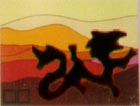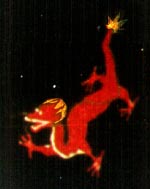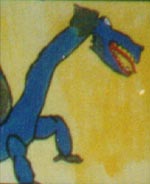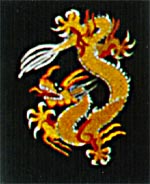
dragon
from the Latin dracon-em, from the Greek
δρακων, -oντα;
usually referred to δρακ- strong aorist stem of
δερκεσθαι
to see clearly
Oxford English Dictionary

Dragon screen saver
Dragon Cutlets used to hang above the stove in the kitchen,
and brought success to all cooking endeavours.
His place has now been taken by an extractor fan,
but his memory lives on. This
screen saver of the
Dragon Cutlets Mobile is his memorial.

A Dictionary of Symbols, by J.E.Cirlot

DRAGON (le dragon)
Dragons are very little used in European cookery. They are, however, much prized
by the Arabs and Chinese, who regard the claws and the tip of the tail as great delicacies.
All recipes for basilisk are suitable for dragon (see BASILISK)
Larousse Gastronomique

A Dictionary of Symbols, by J.E.Cirlot